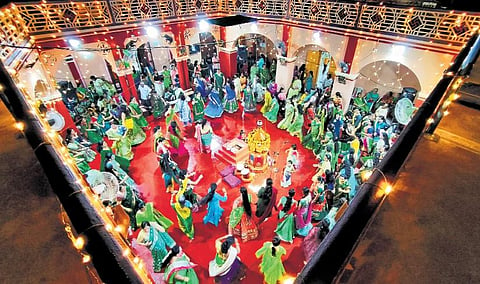

KOCHI: Navratri is a celebration of Adi Parashakti – the supreme feminine energy, considered the primordial cosmic power in Hinduism. She is revered in various forms such as Durga, Kali, Parvati, Saraswati and Lakshmi during the nine-day festival.
For Malayalis, the final three days of Navratri—Ashtami, Navami, and Vijayadashami—are paramount, primarily observed with worship of Goddesses Saraswati and Durga.
However, being a melting pot of cultures, Kochi plays host to diverse celebrations and rituals, including Gujarti’s garba, Tamil and Konkani bommai kollus, and Bengali Durga pujas, over the nine days and nights.
Garba-dandiya raas
The favourite dance festival of Gujarat – the garba – is performed in the evenings by people across age groups. Having settled in Mattacherry for over 500 years, the Gujarati community has made it Kochi’s own gala.
Women in chaniya choli (traditional Gujarati dress) and men in bright kurta-pyjamas perform garba around the idol. “On these nine days of the festival, we worship nine incarnations of Shakti or Goddess Durga — Kali, Jagadamba, Annapoornadevi, Sarvamangala, Bhairavi, Chandika, Lalitha, Bhavani, and Mookambika,” explains Krupa Joshi, a Navaratri Mandal committee member.
Another Mattancherry resident, Swathi Patel, says the “best part” is performing garba with loved ones. “It is a way of rebooting the mind and body,” she adds.
Bommai kolu
As part of the Navratri festival, Tamil and Konkani communities set up bommai kolus at homes and temples. Different dolls and idols of deities and mythological characters are arranged on the nine-step wooden staircase.
“The kolu figurines are arranged in such a way that they celebrate Indian heritage tales, passed on from one generation to another – like the Ramayana, Puranas, and Dashavataram,” says Uma Iyer, a Tamil Brahmin resident of Triputhura.
“During these days, women are invited to homes and given gift sets consisting of vermilion, bangles, and sweets. On the ninth day, girls under the age of 10 are invited and worshipped, and on the 10th day, we worship Goddess Saraswati.”
Durga puja
It is a significant celebration among the Bengali community. While Durga Maa is revered as Mother Supreme, celebrations include deities such as Lakshmi, Saraswati, Ganesha, and Kartikeya as well. “These deities are considered to be Durga Maa’s children. Durga puja celebrates her visit to her natal home with her children,” says Surjit Ghosh, member of the Keral Banga Samskriti Sangha.
“The festival ends on the tenth day, when devotees embark on a procession carrying the clay idols to a river for immersion. It is believed that, after the immersion, she returns to her divine cosmos – back home with Lord Siva in Kailash.”
Vidyarambham
Like most Devi temples in Kerala, the ancient Iringole Kavu, a forest temple dedicated to Goddess Durga, celebrates Navratri by organising dance and music performances of children throughout the nine days. On Vijayadasami Day, Vidhyarambam is celebrated here. “The idol at this temple is considered to be the eighth child of Devaki and Vasudeva, who were imprisoned by Kamsa. It is said that when Kamsa attempted to kill the newborn baby, it rose to take the form of Goddess Durga, and appeared in the sky with lighting. The place where the lightning struck on earth was called Irunnol, and that later became Iringole. The Goddess here is believed to be Lord Krishna’s sister,” says a committee member of the temple, Prasad.